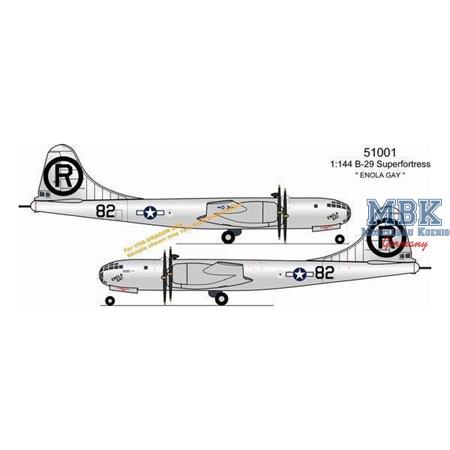B-29 Superfortress Enola Gay (1:144)
51001
DRAGON WARBIRDS
1:144
Achtung Maßstab 1:144
NEW Scale in the Dragon Warbirds series!!!
1/144 B-29 Superfortress \"Enola Gay\"
Tail#: 44-86292
The first model in our new scale will be the infamous \"Enola Gay\" with all of the detail you\'ve come to expect from Dragon. At over 8\" long and almost 12\" wide, this model is a must for any aviation enthusiast!
Main Features:
- Fully detailed 1/144 B-29 mold approved by Boeing
- Diecast metal fuselage and wings
- Bomb bay door can be positioned as open or closed
- Detailed Bomb payload (when bay door is open)
- Removeable landing gear (can be posed in a flying or landing configuration)
- Clear parts for the nose
- Rotating propellers
- Accurate engraved panel lines
- Historically accurate markings
- Pre-assembled
- Dimensions: 8.25\"L x 11.77\"W x 2.31\"H
About the \"Enola Gay\":
Perhaps the most recognized B-29 is the Enola Gay, which dropped the atomic bomb \'Little Boy\' on Hiroshima on 1945 August 6.
The Enola Gay was assigned to the U.S. Army Air Force\'s 509th Composite Group and flew the August 6 mission out of Tinian, a small island in the Mariana Islands chain. The plane was one of only 15 B-29s modified to deliver nuclear bombs. The Enola Gay was modified at Offutt Air Force Base to hold the atomic bomb. Its crew had undergone training at Wendover Army Air Field in Wendover, Utah.
Colonel Paul Tibbets, normally commander of the group, elected to fly the mission himself. Thus, he selected a plane from his group and renamed the plane after his mother Enola Gay Tibbets.
The Enola Gay has been fully restored and is now on display at the Steven F. Udvar-Hazy Center at Dulles International Airport.
About the B-29:
The Boeing B-29 Superfortress (Boeing Model 341/345) was a four-engine heavy bomber flown by the United States Army Air Force. It was one of the largest aircraft of World War II to see active service. When it entered service, it was one of the most advanced bombers of its time, featuring innovations such as a pressurized cabin, a central fire-control system, and remote-controlled machine gun turrets. It was designed to be a high altitude daytime bomber, but was most used in low-altitude night time incendiary bombing. It was the primary weapons platform used in the United States fire-bombing campaign against Japan in the final months of World War II, and B-29s carried the atomic bombs that destroyed Hiroshima and Nagasaki. Unlike many other bombers, the B-29 remained in service long after World War II ended, a few being employed as flying television transmitters for Stratovision. By the time it was retired in the 1960s, some 3,900 planes had been built.
Schreiben Sie jetzt Ihre persönliche Erfahrung mit diesem Artikel und helfen Sie anderen bei deren Kaufentscheidung.



